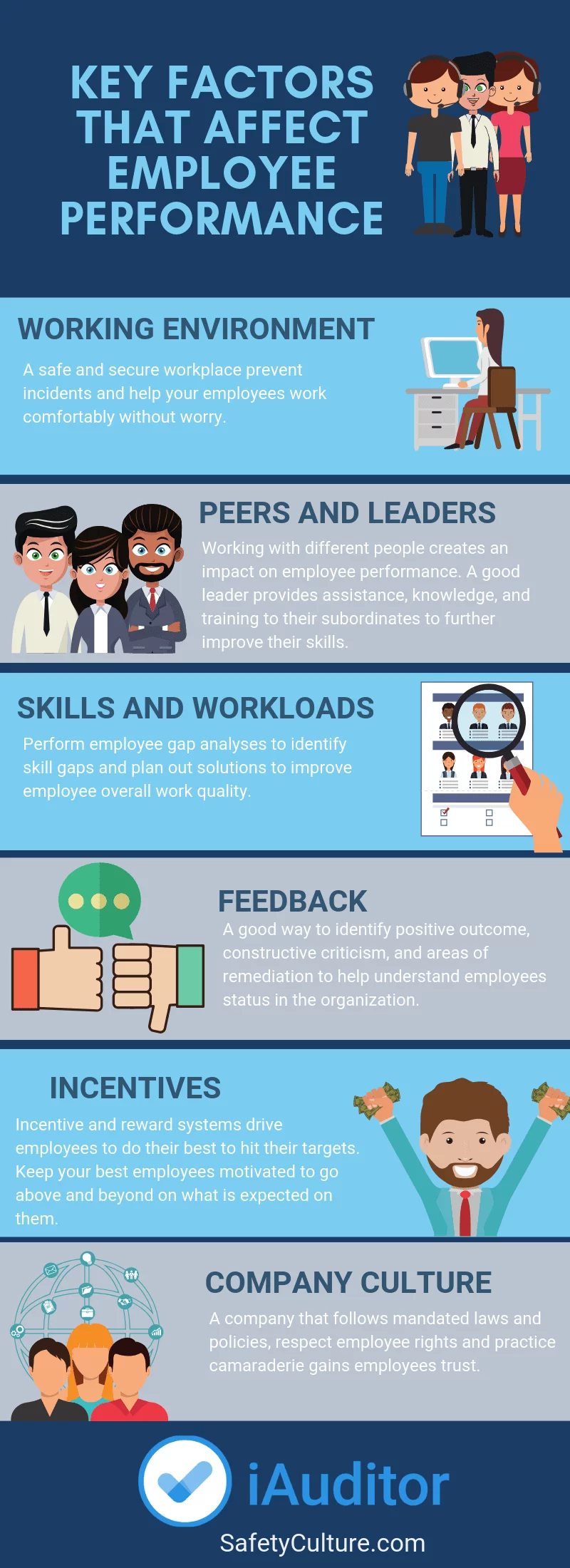Guest Post by Jona Tarlengco, SEO Content Specialist, SafetyCulture.
Have you ever wondered why some employees deliver beyond expectations while others do not? Employees are the main contributors to a business, and its growth and success depend largely on their performance. Learn to manage employee performance strategically and evaluate whether to upscale employees or let them go. Here are the key factors that commonly affect employee performance.
Working Environment
An employee exposed to repetitive movements and static postures at work is at high risk for musculoskeletal injuries. A good working environment implements ergonomic solutions to address injury risks. Here are some practices you can follow to ensure a safe workplace:
- Train employees with ergonomic principles to promote awareness of body limitations.
- Provide ergonomic workstations and modify existing equipment to eliminate awkward postures.
- Make work practices more efficient to help employees minimize excessive overtime that causes fatigue and stress.
- Maintain a safe and secure workplace to prevent incidents and help employees work in a comfortable environment.
- Allot the right number of employees for a certain task to reduce individual workload.
- Encourage employees to take micro-breaks to prevent them from staying in a static position for long periods.
- Adjust furniture and peripherals according to employees’ height to promote proper body posture.
A safe and healthy working environment helps protect employees from illnesses and work-related injuries. It also helps boost employee morale and increase employee productivity.
Peers and Leaders
Working with different people creates an impact on employee performance, which can either be positive or negative. Being able to share ideas and perspectives with others gives an employee the freedom to work without pressure, allowing them to hit their targets and be more productive. Having a positive attitude is essential for employees to work efficiently and harmoniously with others.
Working with different people helps develop employees’ collaboration skills and will help them bring about the best solutions for their projects. It also helps gather different insights and information, which fosters a spirit of unity among employees and helps them work together to achieve a common goal.
Leaders are essential for any team. A good leader influence inspires and motivates their teammates to have a positive attitude and work efficiently together. Your team should be led by someone who knows how to listen to people. Ensure that leaders can provide the necessary assistance, knowledge, and training to their subordinates to further improve employee skills. Ensuring that your employees’ skills are up to date empowers them to perform at their best to achieve business goals.
Skills and Workloads
There are a few questions you should ask yourself when it comes to your employees: Are these employees fit for the job/role? Are they skilled enough to perform their respective tasks? Do they need additional training? Does the company provide the necessary tools to help them perform their job easily, comfortably, and safely? If you answered no to at least one of these questions, improvements need to be made to your organization.
It is important to know employees’ skill sets and capacity before assigning workloads. You cannot expect proper medical attention from the accounting department or accurate balance sheets from the IT department. Skill sets and training should match accordingly to help employees perform tasks efficiently. Skills training will vary depending on the needs of employees, but it is nevertheless necessary, especially if there are obvious skill gaps.
Skills training can help develop two kinds of skills: 1) soft skills – including communication, critical thinking, leadership, adaptability, and work ethics. 2) hard skills – including technical, programming, in-house processes, accounting, and data analysis. In some cases, skills training may be required to help employees achieve the targeted goals.
How can you determine the skills needed by your employees?
Perform employee gap analyses to identify employee skill gaps and plan out corrective solutions. This will help improve overall work quality and ensure employees are fit for the assigned role.
Feedback
Employees cannot improve themselves if they don’t know which areas to improve with regard to their job performance. Giving feedback is a good way to identify positive outcomes, constructive criticism, and areas of remediation to help understand employee standing in the organization.
Feedback is a good way to motivate employees because it opens a line of communication between you and your employees. It fosters an atmosphere of honesty and transparency across the organization and helps eradicate misunderstanding. Open communication helps uncover solutions on how employees can improve their overall performance.
Giving employees relevant feedback allows them to continuously learn and improve themselves, create new strategies, and develop service improvements. It also helps streamline processes that guide employees in achieving their goals.
Positive feedback can go a long way in boosting employee morale, which positively affects their performance. This lets them know that their contributions were highlighted and appreciated by the organization.
Incentives
Incentives and reward systems drive employees to do their best to hit their targets. Rewards provide validation and acknowledgment of their contribution to the business. It also lets them know if they are consistently hitting their targets and doing their job well.
Implement incentive programs to keep your best employees motivated to go above and beyond what is expected of them. This helps inspire other employees to keep up the good work since they know that the organization recognizes their efforts.
There are two types of rewards you can offer to your employees:
- Monetary Incentives – these are financial rewards which include a salary appraisal, cash bonuses, and profit-sharing.
- Non-monetary incentives – these are privileges given to employees such as flexible work schedules, remote working access, and additional leave credits. It also includes the recognition that leads to professional growth like promotions and other career opportunities.
Company Culture
Employees who share the same beliefs that align with the organization’s vision are more likely to be productive. A company that follows mandated laws and policies, respects employee rights, and practices camaraderie gains employees trust and boost their morale.
Company culture represents the organization’s mission, values, and ethics. It should be reflected in employees’ actions and views towards company goals. An employee who fits the company culture is most likely to have a positive outlook and be an efficient worker who finishes tasks on time.
Adopt a culture that respects and motivates employees. Provide the necessary resources to help employees reach their maximum potential and never fail to acknowledge a job well done. Conduct regular employee evaluation and feedback sessions so you have a recorded assessment of their performance to help determine whether an employee needs career development, further appraisal, or termination.
***
Jona Tarlengco is a content writer for SafetyCulture, a software company that enables businesses to perform inspections using digital checklists. The team at SafetyCulture has created the world’s most used checklist inspection app, iAuditor. They make it affordable and accessible for everyone to manage safety and quality. Connect with SafetyCulture on Twitter. Have questions for Jona? Write to her at jona.tarlengco@safetyculture.io






